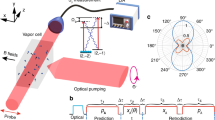Abstract
According to the causal interpretation of quantum mechanics, one can precisely define the state of an individual particle in a many-body system by its position, momentum, and spin. It is shown in the EPR spin experiment that the quantum torque brings about an instantaneous change in the state of one of the particles when the other undergoes a local interaction, but that such a transfer of “information” cannot be extracted by any experiment subject to the laws of quantum mechanics.
Similar content being viewed by others
References
D. Bohm,Phys. Rev. 85, 166, 180 (1952).
D. Bohm, R. Schiller, and J. Tiomno,Suppl. Nuovo Cimento 1, 48 (1955).
T. Takabayasi,Prog. Theor. Phys. 14, 283 (1955);70, 1 (1983).
C. Dewdney, P. R. Holland, and A. Kyprianidis,Phys. Lett. A 119, 259 (1986).
C. Dewdney, P. R. Holland, and A. Kyprianidis,Phys. Lett. A 121, 105 (1987).
P. R. Holland, “Causal interpretation of a system of two spin-1/2 particles,” IHP preprint, 1987.
A. Einstein, B. Podolsky, and N. Rosen,Phys. Rev. 47, 777 (1935).
D. Bohm,Quantum Theory (Prentice-Hall, Englewood Cliffs, 1952), Chap. 22.
C. Dewdney, P. R. Holland, and A. Kyprianidis,J. Phys. A: Math. Gen. 20, 4717 (1987).
C. Dewdney and P. R. Holland, inQuantum Mechanics Versus Local Realism—The Einstein-Podolsky-Rosen Paradox, F. Selleri, ed. (Plenum, New York, 1987).
C. Dewdney, P. R. Holland, A. Kyprianidis, and J. P. Vigier,Nature (London), in press, 1987.
G. C. Ghirardi, A. Rimini, and T. Weber,Lett. Nuovo Cimento 27, 293 (1980).
P. J. Bussey,Phys. Lett. A 90, 9 (1982).
D. N. Page,Phys. Lett. A 91, 57 (1982).
T. F. Jordan,Phys. Lett. A 94, 264 (1983).
A. Shimony, inFoundations of Quantum Mechanics in the Light of New Technology, S. Kamefuchiet al., eds. (Physical Society of Japan, Tokyo, 1984), p. 225.
F. London and E. Bauer, inQuantum Theory and Measurement, J. A. Wheeler and W. H. Zurek, eds. (Princeton University Press, Princeton, New Jersey, 1983), p. 217.
C. D. Cantrell and M. O. Scully,Phys. Rep. 43, 499 (1978).
L. de Broglie,Non-Linear Wave Mechanics (North-Holland, Amsterdam, 1960).
A. Kyprianidis,Phys. Lett. A 111, 111 (1985).
P. R. Holland,Found. Phys. 17, 345 (1987).
J. P. Vigier,Astron. Nachr. 303, 55 (1982).
Author information
Authors and Affiliations
Additional information
Dedicated to David Bohm on the occasion of his 70th birthday.
Rights and permissions
About this article
Cite this article
Holland, P.R., Vigier, J.P. The quantum potential and signalling in the Einstein-Podolsky-Rosen experiment. Found Phys 18, 741–750 (1988). https://doi.org/10.1007/BF00734154
Received:
Issue Date:
DOI: https://doi.org/10.1007/BF00734154




